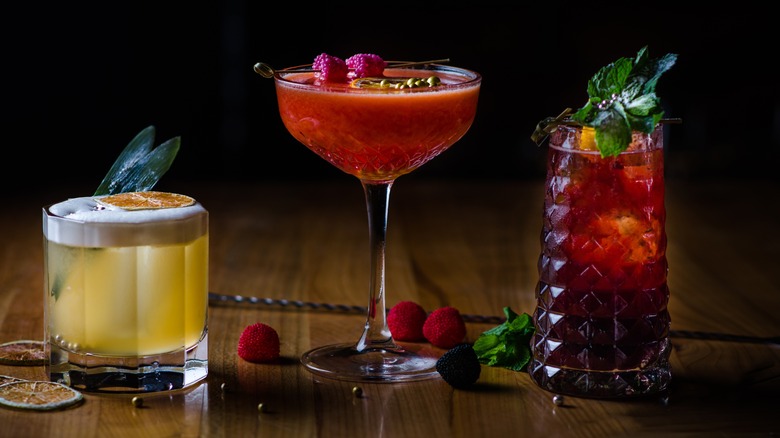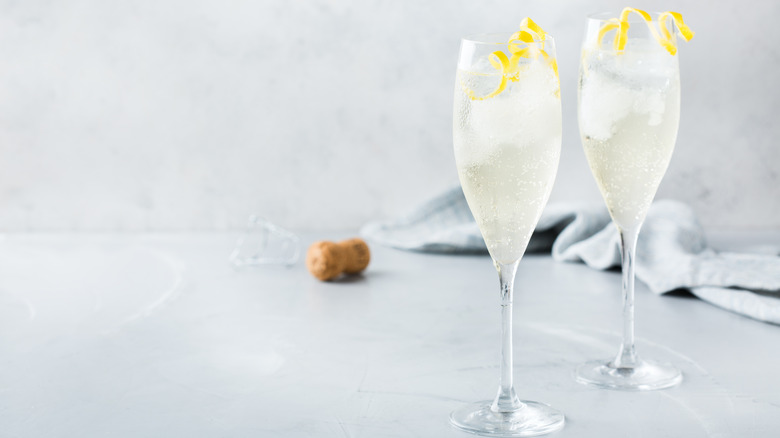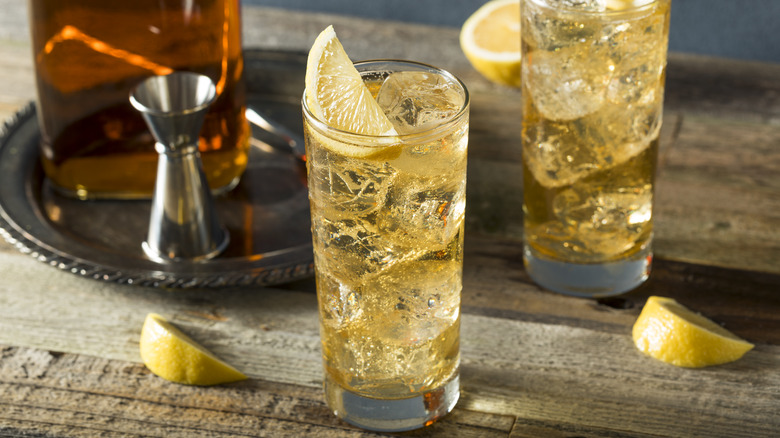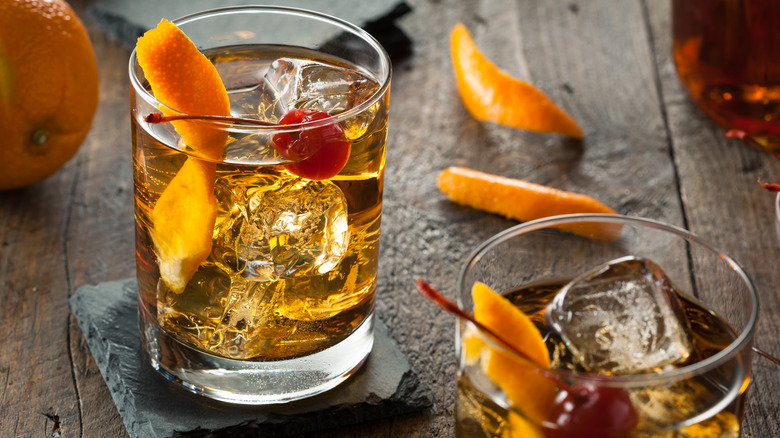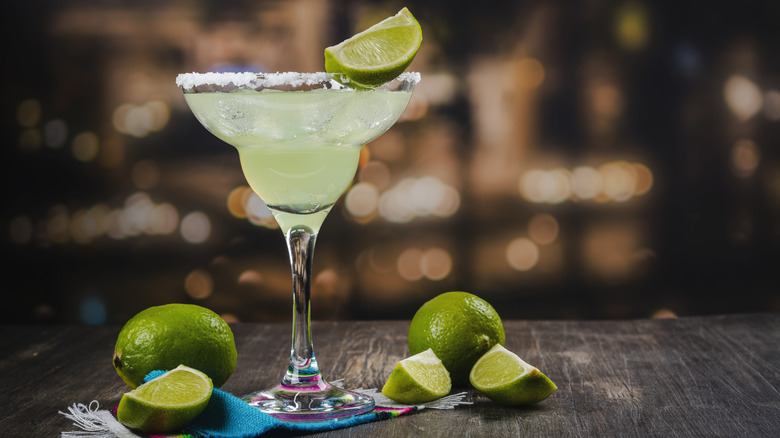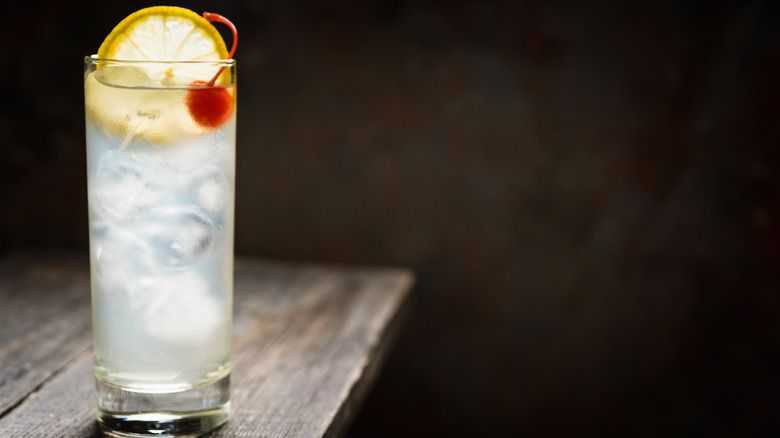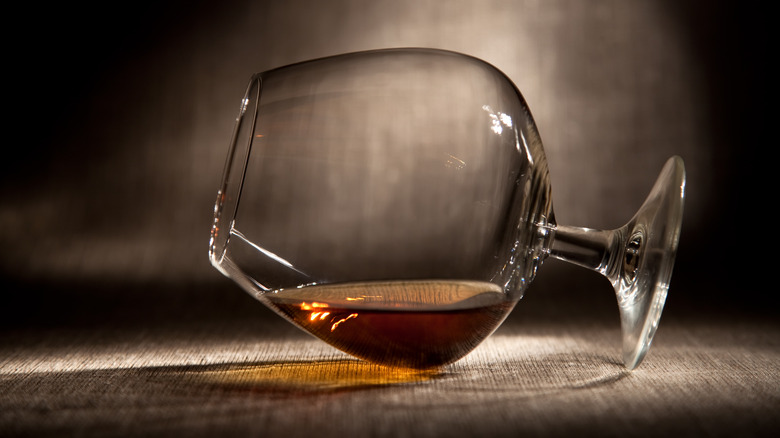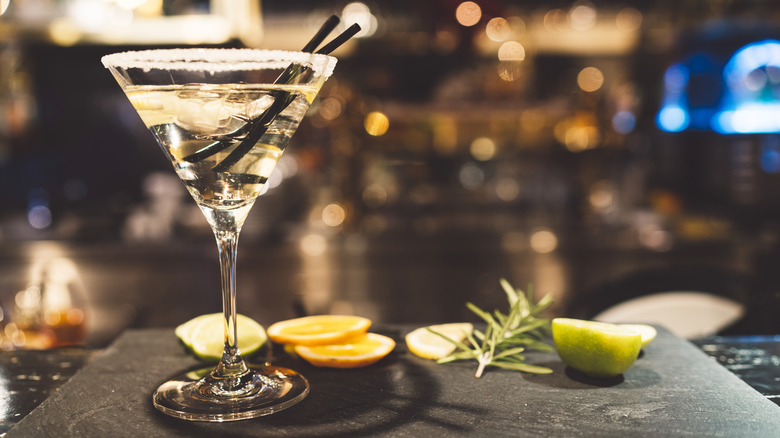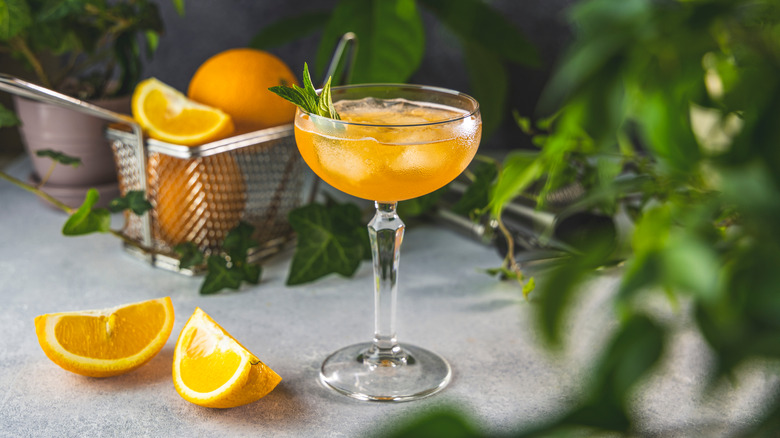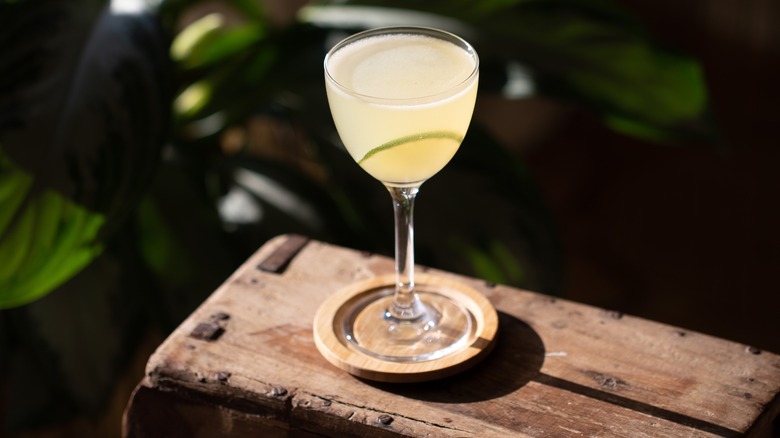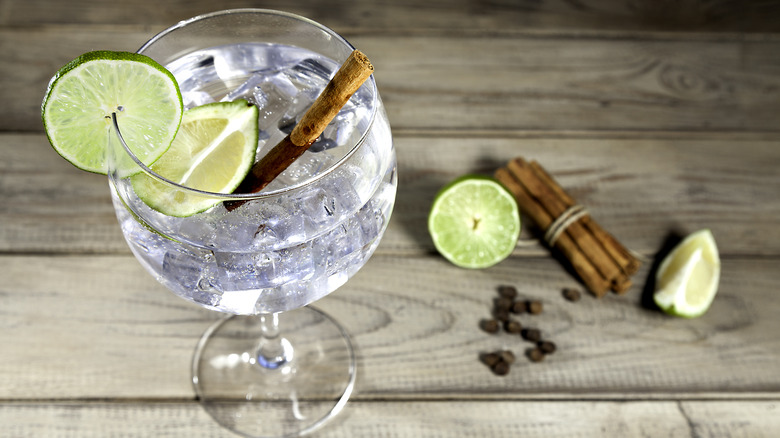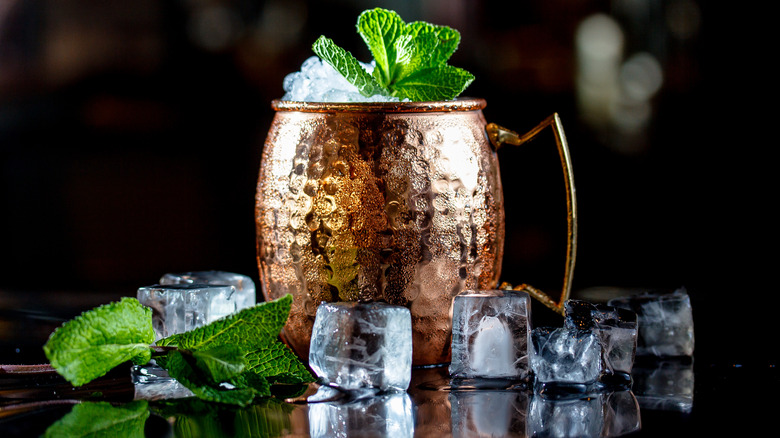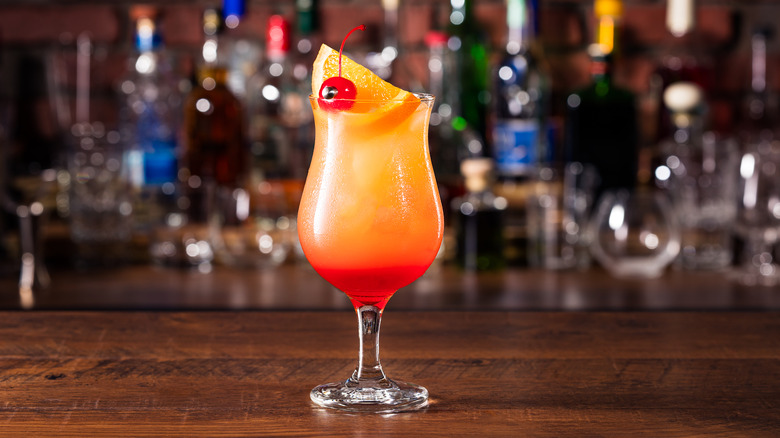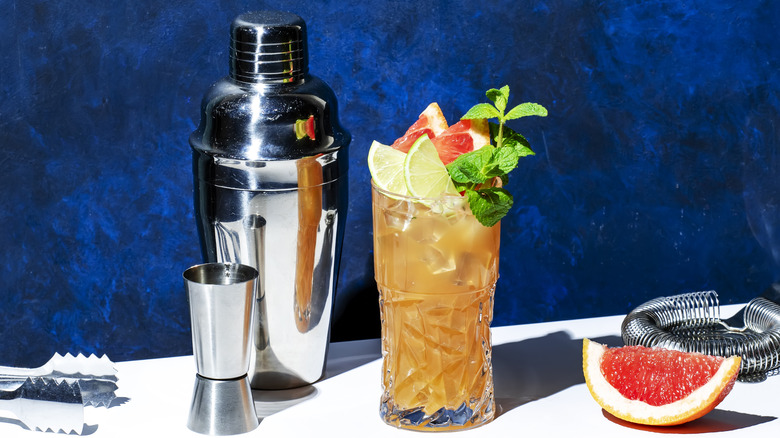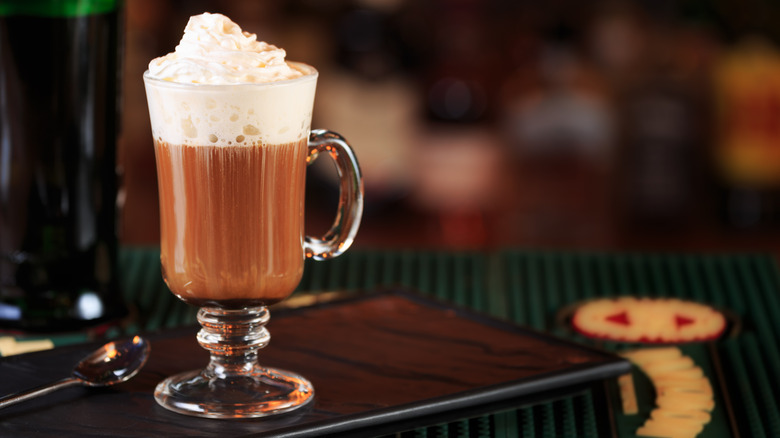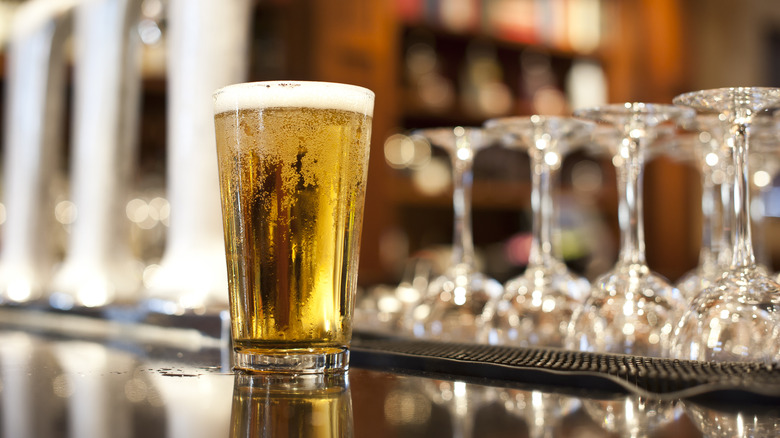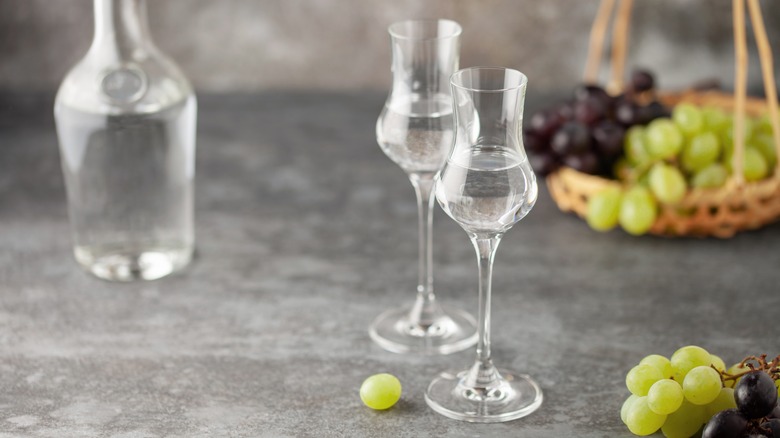16 Cocktail Glasses And The Right Way To Use Them
Creative cocktails are having a moment. Spend a few minutes following any mixologist on social media and you will inevitably fall in love with whatever eye-catching, perfectly executed tipple they're making and find yourself racing out to shop for every specialty spirit, ingredient, and garnish. You'll get home to try all these new cocktail recipes only to feel a bit let down when you go to serve them in your run-of-the-mill, all-purpose drinking glass. I've worked in the adult beverage business for close to two decades, from consulting, to writing about, to buying and selling wine and spirits, and few things are as satisfying in the drinks world than a gorgeous cocktail served in the perfect stem.
"Glassware is a very important part of cocktail making," says Leandro DiMonriva of The Educated Barfly, who compares glass choice to the way a chef plates a certain dish. "The vessel type will completely determine how the drinker perceives a drink and sometimes how they interact with it."
You could easily get carried away with having a specific glass for every different cocktail if cabinet space were no object. However, most of us mere mortals can only house so much stemware. I caught up with a few drinks professionals to discuss tips and tricks on what all the different types of glassware are typically used for, and how we can best stock our own home bars based on the types of drinks we prefer.
Flutes aren't just for music and bubbly
When someone mentions a Champagne toast, our minds immediately picture those classic, tall, flute-shaped glasses filled to the brim with bubbly. The truth is, when it comes to how you serve your Champagne, flutes are actually pretty divisive. Although the narrow shape of the glass shows off the wine's festive fizz, that same shape doesn't always work to let the classic toasty aromas of true Champagne shine.
Fortunately, there are plenty of other glasses that are great for your enjoyment of bubbly, including gorgeous variations on the flute, like the curvy tulip and the bold trumpet-shaped stem. An all-purpose wine glass is also a favorite among wine professionals and sommeliers for sparkling wines.
Nevertheless, many in the beverage industry (myself included) still believe the flute is an essential stem to have on hand, both for a sparkling wine toast and for one of our favorite purposes — a bubbly cocktail. Go for the popular mimosa or bellini, or try your hand at one of the many creative cocktails that are perfect for Champagne lovers.
For a simple mixed drink on ice, go with a highball
Although likely named for the original whiskey highball cocktail made of whiskey, ice, and club soda or carbonated water, the term highball now refers to basically any drink made from a combination of spirit and carbonated mixer served over ice. Not to be confused with the closely related Collins glass, the highball glass typically holds anywhere from 8-12 ounces and is great for building these carbonated mixed cocktails thanks to their tall, narrow shape that holds ice and a lot of liquid.
"A highball is a great multipurpose and general-use glass to have on hand," says Christiane Jones, head bartender at Chinese Tuxedo in New York. "While it can (obviously) be used to serve a classic highball drink, it's also perfect for any one-and-one or other cocktails served with a large mixer-to-liquor ratio." Drinks that are regularly made and served in highball glasses include simple tipples like a gin and tonic, vodka soda, and rum and coke, although, when it comes to cocktails, there is no need to stand on ceremony. The ample space in a highball glass will allow you to get creative. One of our favorites for this type of vessel? A cool, refreshing mojito.
There's nothing old fashioned about a rocks glass
This is the traditional glass used for the classic Old Fashioned cocktail, but this by no means limits what you can put in this glass shape. Also known as a rocks glass, lowball, or whiskey glass, these are great for simple drinks built directly in the glass itself, rather than a cocktail shaker or mixing glass. So named for the ice "rocks" that it's typically filled with, the rocks glass has a short, stocky, often heavy-bottomed structure that makes it ideal for sipping spirits by themselves. It's also a great glass for showing off a gorgeous single large cube or sphere of ice.
This is such a simple, elegant glass that really lets the drink speak for itself. "These short, squat glasses are used for a wide range of drinks, from simple, neat pours, through boozy cocktails like the Old Fashioned, and even refreshing juicy drinks like a margarita," says H. Joseph Ehrmann, proprietor of Elixir in San Francisco and chief mixology officer of Fresh Victor Cocktails. "They're also popular for sours."
If you're feeling extra creative, take a few years off an Old Fashioned with a variation that adds a touch of sweet lavender to the traditional recipe. If Old Fashioneds or a simple whiskey on the rocks aren't your thing, another drink that looks and tastes great in this glass shape is a vibrant, bitter-sweet classic Negroni cocktail.
Close your eyes and you're in Cancun with a margarita
You know the style of glass — that whimsical, upside-down sombrero shape, featuring a big, shallow bowl and long stem. It's the glass that's always somehow spilling over with frozen, flavored, or just a simple, perfect margarita on the rocks. "While not entirely necessary to enjoy a margarita — a rocks glass will do just fine — it's the extravagance of a stemmed margarita glass that can elevate the experience of serving and enjoying the cocktail," says Christiane Jones. "It's fun and it's a little over the top but it is an easy way to make you feel like you're on vacation when it's really just Wednesday."
There are many legends about how the margarita glass got its shape. No matter the real story, the bottom line is that the glass makes sense for creating a salt or sugar rim, showing off the color of this festive drink, and keeping your hands from getting too cold or too sticky while sipping. There are also colorful and hand-blown versions of this dramatic glass out there that can add color and flair to any backyard party.
Collins, not to be confused with a highball
Named after the classic Tom Collins cocktail, this glass is similar to and often used interchangeably with a highball glass, but there are important, distinct differences. While a highball glass is generally used for simple mixed drinks that contain a spirit, ice, and a carbonated mixer, the Collins glass is taller and holds a bit more liquid — 10-14 ounces compared to the highball's 8-12 ounces. This additional volume makes it possible to hold drinks made with more ingredients. Like the highball glass, the narrow shape of the Collins allows ice to stack, causing it to melt more slowly, and minimizes air contact with the liquid, which helps maintain carbonation longer. Who knew drinking could be so scientific?
The Collins glass falls into a category of barware called "chimneys," which are all tall, steep glasses of varying sizes. Leandro DiMonriva believes you need at least four of either this or the highball style of glass on-hand thanks to their versatile functionality. I love to bring out a tray of brightly colored watermelon palomas, made with tequila, watermelon purée, agave syrup, lime, and sparkling water, on a hot summer day in these tall glasses.
Snifters help you sniff your spirit
These pear-shaped glasses with a distinct tulip-like flare are suited for strong spirits that have powerful aromatics. The bowl of the snifter offers room for oxygen to be incorporated into the spirit as you swirl it, releasing the volatile aromatic components of the liquid, and then refocusing them on their way out so you experience all the senses when sipping. The unique, bulbous shape of the glass also allows us to hold it so that we can warm the liquid using the heat from our hands, which further enhances the drink's aromas.
While traditionally used for brandy, a snifter is actually far more versatile. "A snifter is lovely for aerating and swirling a neat spirit, allowing you to smell and taste the spirit," says Christiane Jones. Use this elegant, specialty glass to explore the nuances of some of the exciting craft rums out there, or use your snifter to sip a small-batch bourbon. Some even recommend serving certain styles of ale in snifters, so don't feel this glass is a one-trick pony if you don't sip a ton of brandy or straight spirits.
Shaken or stirred, the martini glass is a classic
Nothing adorns a bar cart quite like the martini glass. Perhaps one of the most iconic and ubiquitous cocktail vessels in my experience in the beverage industry, there's plenty of good reason behind the shape of a classic martini glass. Beyond good looks, the steep, sloping walls of the glass keep ingredients in the martini — whether shaken or stirred — from separating, and provide a sturdy yet elegant support for propping up garnishes like an olive, onion, or twist.
Although James Bond may have been very particular about how his chosen martini was prepared — 3 ounces of gin, 1 ounce of vodka, ½ ounce of Lillet, with a twist, aka a Vesper martini — there are plenty of variations on the basic martini recipe, as well as other popular cocktails that look and taste great in this classic stem. These include the beloved Manhattan, the always-fun Cosmopolitan, and the espresso martini cocktail, which is having a bit of a moment right now.
The coupe is both old and new school
The popular coupe glass was long used as the stem of choice for sparkling wine and Champagne, however, its usage has evolved over the years. While the rumor that this glass originated thanks to Marie Antoinette requesting a champagne glass modeled in the shape of her breast has never officially been proven, this tale has only served to enhance the allure of this trendy stem.
Despite it actually being ill-suited for bubbly — the wide bowl does little to preserve the fizziness in the sparkling wine — the glass is often used as a retro option for serving fizz, especially the dramatic Champagne towers we see at lavish food and wine events and parties. It's also a great throwback silhouette for a touch of vintage glamor when serving favorites like daiquiris, sidecars, and even martinis. In fact, Leandro DiMonriva suggests that the coupe glass may be among the most essential of all barware in your home. "This will take the place of the martini glass and sour glass so you don't need to buy them separately," he says.
Today's elegant all-purpose cocktail glass is the Nick and Nora
This modern glass falls somewhere in between a coupe and a martini glass and is a must-have in today's cocktail culture. Slightly smaller in size, the Nick and Nora is emerging as "an elegant presentation of generally stirred cocktails," says H. Joseph Ehrmann. Chances are you've seen this stem show up in some of today's sexiest mixology content as a go-to vessel for creative drinks, but my absolute favorite to serve in a Nick and Nora is simple, traditional daiquiri cocktail, made with nothing more than rum, simple syrup, and lime juice.
The origins of this quirkily named cocktail glass are cinematic in nature. Nick and Nora Charles are characters in a 1934 detective novel and movie "The Thin Man." Needless to say, the couple find themselves entangled in a murder mystery set in New York City, fueled on — you guessed it — cocktails served in these tiny, now-iconic glasses. Today, the diminutive Nick and Nora stems can be found at just about every hip drinking establishment and are perfect vessels for a wide range of cocktails, but primarily those that are intended as small but potent sips.
For the perfect G&T, opt for a balloon
The copa de balon, also known as the balloon glass, is made for long cocktails over ice. I have distinct memories of traveling throughout Spain, where this glass shape originally gained popularity, and ending up at various watering holes late at night sipping perfect gin and tonics served in these, which has since become my preferred way to serve this botanical cocktail.
The billowy glass features a large bowl and narrow mouth, making it ideal for drinks that are best served over plenty of ice with lots of garnishes to enhance the appearance and flavor of the drink. The narrow mouth allows the bowl of the glass to capture and hold the botanical aromatics that gin-based cocktails are known for. Leandro DiMonriva suggests having at least two balloon glasses on hand for gin and tonics as well as refreshing spritzes — Hugo, Aperol, or otherwise. You never know when that backyard barbecue or pool party is going to call for this type of cooling sip.
Go metal with a mule
These became all the rage a few years ago for presenting the easy, refreshing Moscow mule — a pungent mix of vodka, lime juice, and ginger beer. The distinct, squat copper mug with a small handle, hammered surface, and stainless steel interior is said to not only keep the beverage icy cold but also enhance the herbaceous aromatics of the ginger beer.
Fortunately, if Moscow mules aren't your thing, there are many other variations on the drink, like the Mexican mule, made with tequila instead of vodka and sweetened with a bit of agave, simple syrup, or splash of orange juice. This style of metal vessel can be used for other cocktails, like the quintessential Kentucky Derby drink, the mint julep. Although a mint julep chalice is technically a different glass, the two can be used interchangeably thanks to the role the metal material plays.
And there's just something about sipping an icy cold cocktail out of a metal glass that feels right. "Sometimes the glass is functional like a mint julep chalice [or mule mug] that keeps the drink a little colder over time and, as a result, helps the drink (usually served over crushed ice) stay less diluted over time," says Leandro DiMonriva. But he also recognizes that there's a certain je ne sais quoi about this vessel: "It's a way to tell a story with your drink," he says.
Rock your cocktail in a hurricane
Legend has it this curvy glass got its name in New Orleans, where it was made famous by the cocktail of the same name. The hurricane cocktail is believed to have been born at the historic Pat O'Brien's bar in the French Quarter during World War II. Sitting on a large overstock of rum, O'Brien apparently created the cocktail as a way to generate interest in and use up the spirit since the more popular bourbon and Scotch were in short supply after the war. The drink was served in a glass closely resembling a hurricane lamp and the rest, as they say, is history.
Today, the hurricane glass is typically used in festive drinking establishments for fun and fruity drinks like piña coladas, frozen daiquiris, and, of course, the classic hurricane cocktail, made with layer upon layer of fruit juices, rum, and grenadine, and garnished with the signature orange slice and maraschino cherry. "Hurricane glasses are antiquated and specialized glasses most people don't use anymore," says Leandro DiMonriva. But you, friend, are not "most people," so get out there and turn your kitchen into a hopping New Orleans bar with a round of juicy hurricane cocktails next time you have friends over.
For throwback tiki vibes, go with a zombie
Like the hurricane, the zombie glass gets its name from an iconic cocktail of the same name. World War II veteran Don Beach created the zombie cocktail at the now-legendary Don the Beachcomber bar he opened in Los Angeles in 1934. Beach, who was widely considered to be the founding father of American tiki culture, apparently created and served the cocktail to a severely hungover customer who needed to get through a business meeting, only to have the customer later return to say the cocktail made him feel like a zombie thanks to its high alcohol content masked by the drink's sweet, fruity flavors.
The zombie glass falls somewhere between a hurricane and a highball glass and can be used interchangeably with the two. Today, it's typically a tall, narrow glass designed to hold fun tiki cocktails and mixed drinks like the tequila sunrise, mai tai, or fuzzy navel. However, there are more whimsical versions out there, featuring tiki-themed touches and etchings of moai statues. "I wouldn't say [zombie glasses] serve the drink any better than a rocks or Collins glass," says Christiane Jones. "However, they make the drink an experience and, in social media culture, make for great pictures and memories. It's easy to remember a bar or night out when you remember the glass you had in your hand."
Make a warm and toasty tipple in an Irish coffee mug
Sure, you can make the classic and decadent Irish Coffee, made famous at the Buena Vista bar in San Francisco, but this all-purpose footed glass is perfect for other warm drinks like a hot toddy or a simple coffee with Baily's Irish Cream, too. "It was originally used for Irish coffees," says H. Joseph Ehrmann. "But they're now used for other hot cocktails as well as a lot of sours and flips" — frothy cocktails made with egg, sugar, and a spirit.
This type of glass isn't just designed this way because it's reminiscent of a coffee mug; it actually serves an important purpose when crafting your Irish coffee or other hot tipple. The height of the glass allows for an artful dollop of hand-whipped or store-bought cream atop your drink, an absolute must when mixing the bitter notes of brewed coffee with the spicy heat of a shot of whiskey. The glass also features a sweet little handle, allowing you to protect your paws while you sip your steaming beverage, because nothing kills a nice, warming buzz quite like third-degree burns to the knuckles.
The all-purpose pint glass is a familiar friend
Sure, this spacious glass is great for housing a frosty brew, but it's also ideal for serving beer-based cocktails. In fact, the humble pint glass may as well be considered the great workhorse of the home bar world and is a perfect go-to for pretty much any mixed drink over ice. They are also essential for that nightstand water after an evening of a few too many. Christiane Jones agrees. "I consider them more of a water glass," she says. "They are big and usually thicker glass (to be chilled for beer), so they're kind of heavy and awkward for some cute cocktail since it wouldn't fill the glass."
If you're convinced that beer (or water) is what belongs in your pint glass, consider using beer as your base and building one of the many refreshing mixed beer drinks out there, like the savory, super-garnished Michelada — beer's answer to the Bloody Mary — or the controversially named Irish Car Bomb, which packs a punch thanks to its potent combination of Guinness, Jameson Irish Whiskey, and Bailey's Irish Cream. I'm also a fan of whipping up a boozy milkshake and serving it in a pint glass for a decadent adult treat. H. Joseph Ehrmann calls the pint glass "the ultimate party glass — 16 ounces of fun in a simple presentation." We couldn't agree more.
Grab a glass for grappa
I studied wine in Italy for nearly two years. Every time I dined out — once I'd polished off my pasta, finished the bottle of wine, and sipped the last drops of my espresso — someone would inevitably suggest a round of grappa, the misunderstood Italian brandy. In fact, just about every meal in Italy seems to end with a glass of something "for digestion!" This can be an amaro, a sip of limoncello, or, of course, grappa itself, and every Italian will likely assure you that this will help your belly work through the calories you just consumed with ease.
The grappa or digestivo would always arrive in the same style of glass. You've probably seen these stems and wondered what they're for. These are small glasses similar in style to a snifter but feature a longer, more elegant stem, and a smaller, almost shot-glass-sized bowl. The goal for the grappa glass is similar to that of a snifter — incorporate oxygen into the spirit, and then concentrate the delicate aromas in the bowl of the glass. No word yet on whether this shape helps with digestion, though.
Static Media owns and operates Chowhound, Tasting Table, Food Republic, and Daily Meal.
